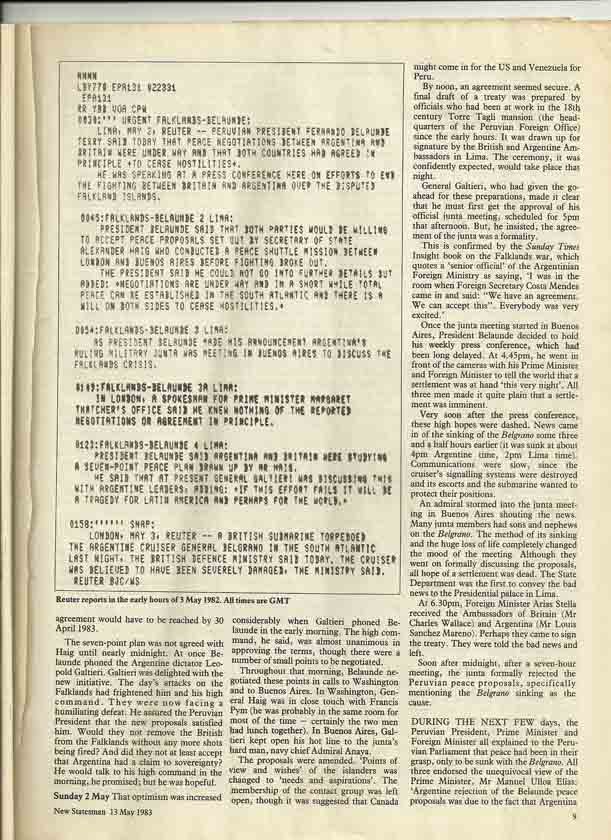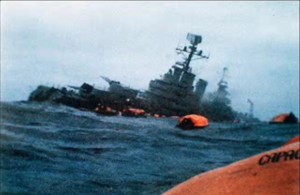Torpedo sank peace hopes – The Sunday Times, 20 March 1983.
The President of Peru, Belaunde Terry, has confirmed that his attempts to prevent the Falklands war failed because the British torpedoed the cruiser General Belgrano, killing 368 Argentinians, as negotiations were taking place. Speaking for the first time of his intervention, he has told an Argentinian journalist, German Sopena, how shocked he was at hearing the news.
Critics of Mrs Thatcher argued that the Belaunde Terry initiative, in early May, offered the strongest chance of preventing war. Belaunde Terry says he felt it was vital to avoid the engagement of the British fleet with the Argentine occupying force. In close consultation with Alexander Haig, then US Secretary of State, he worked out s scheme whereby troops from three friendly countries, Peru, West Germany and the United states, would occupy their islands and supervise the Argentine withdrawal.
When Britain objected to Peruvian troops and Argentina to US forces, the plan was revised to include troops from Australia, or Canada and Venezuela. Belaunde Terry confirms The Sunday Times report, in the book ‘The Falklands War, that the Argentine foreign Minister Nicanor Costa Mendez, considered the proposals acceptable. However as Galtieri and the junta met to discuss the plans, they heard the Belgrano had been sunk.
When Galtieri telephoned him that night, Belaunde Terry said he could understand how the Argentinians must feel and would end his negotiation efforts. – Isabel Hilton
(listen to Guillermo Makin on the Peruvian peace plan: he went with Tam Dalyell to Peru)
• Doc 1: New Statesman article Peace torpedoed
¶ Doc 2:
Text of Observer article:
Four signals intercepted by Cheltenham CGHQ about the movement of the Argentine cruiser General Belgrano, support the view that it posed no threat to the British Task Force off the Falklands when the order was given to sink it
The four Argentine signals, intercepted by airborne monitors in the South Atlantic and relayed to Cheltenham for decoding, were:
- An order to the Belgrano, late on 29 April 1982, to sail on patrol from the Argentine coast past the Falklands to a set point and then return
- An order on 1 May at 7.55 p.m. (London time) for two other elements of the Argentine fleet, the northern and central groups, to sail out and attack the Brititsh Task Force.
- The countermanding of this order within four hours, at seven minutes past midnight.
- An order confirming that the central and northern groups, were to be recalled to safe waters. This was in GCHQ’s hands soon after 5.19 a.m. on 2 May.
These signals show that the Belgrano was not engaged in the Argentine ‘pincer movement’ about which Navy chiefs claimed to have received intelligence. They also show that even the ‘pincer movement,’ involving the two northern groups, had been called off by dawn on Sunday, 2 May, the day War Cabinet members met at Chequers and accepted the urgent recommendation of Admiral Lewin,Chief of Defence Staff, that the Belgrano be sunk.
The GCHQ disclosures, reported last week and confirmed by The Observe r, make clear for the first time why London’s order to sink the Belgrano was so puzzling that it had to be sent three times to the British submarine Conqueror.
The first order was sent at approximately 2 p.pm, but captain Wreford-Brown did not acknowledge receipt. The order was repeated automatically two hours later, but Captain Wreford-Brown sent a signal in return, ensuring that London was notified of the exact details of … the order, at 6 pm, that the captain acknowleged it and torpedied the cruiser, killing 368 men on board.
The intercepted Argentine signals were decoded and telexed at the time directly to Navy HQ at Northwood and to Mrs Thatcher’s office at Checquers.











